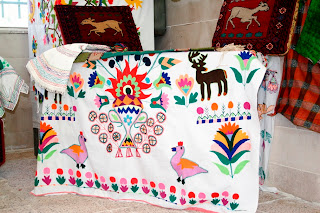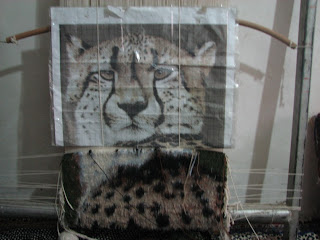Two phenomena of “rural
people’s hospitality” and “local art” are observable in local areas of Iran
while an NGO is working as facilitators, mentors, consultants or implementers of
community based projects with local people. When community members recognize you
as a person/team who supposed to help them to be more empowered in community
development process, they feed you with their local food. It doesn’t matter
what they have at home, they try to do their best for their guests.
The other phenomenon
which is very observable in local market is traditional art. You can see it
everywhere. If you travel from the north to the south or from the west to the
east, there are many small shops selling art products beside the roads. Although
Iran’s market is full of Chinese products, especially during the last five
years, Iranian handicrafts are still luxury products which are being offered by
sellers.
 |
| Zahedan: Mirror made by local women |
 |
| Qeshmi women embroidery |
 |
| Small Cushion: Touran National Park |
 |
| Decorative curtain made of "Peganum.hermla" seed (Espand) |
 |
| Hand made blouse by a local women in a village around Touran Nation Park |
 |
| Handicrafts made by local women, Touran National Park |
 |
| Handicrafts made by local women, Touran National Park |
 |
| Kilim, made by local women in a village named Zaman Abad, Touran National Park |
 |
| Embroidery, made by local women in a village named Ahmad Abad, Touran National Park |
 |
| Small kilim, made by local women in a village named Khankhodi, Touran National Park |
 |
| Small kilim, made by local women in a village named Khankhodi, Touran National Park |
 |
| Wall carpet, woven by local women in a village named Sarab Karian, Kermanshah (North west of Iran) |
 |
| Ceramic bowl and plate, Yazd |
 |
| Wall carpet woven by local women's group in a village named Ahmad Abad during a project for conservation of Asiatic Cheetah, Touran National Park |
 |
| Local industry of copper, Tafresh (my home town) |
 |
| Weaving Giveh, a traditional shoe, Kurdistan |
 |
| Baskets woven by local women, villages in Boushehr (South of Iran, near Persian Gulf) |
 |
| Ceramic shop, Lalejin, Hamedan |
 |
| Wall carpet, woven by local women in a village named Khankhodi, Touran National Park |
 |
| Decorative curtain, Shiraz traditional Bazaar |
 |
| Ahmad Abad village, the facilitator with local governor and local people, conservation of Asiatic Cheetah project, Touran National Park |
 |
| Lunch with members of an NGO, Hamedan (North west of Iran) |
 |
| Lunch with members of a local women's group, conservation of Asiatic Cheetah project, Touran National Park |
 |
| Dinner with a game guard in Bojnourd, Salouk protected area (North east of Iran) |
 |
| Dinner with a game guard in Bojnourd, Salouk protected area (North east of Iran) |
 |
| Tea in a villager's home, project of awareness raising on Asiatic Leopard, a village in Boushehr (South of Iran, near Persian Gulf) |
 |
| Dinner with a villager, project of awareness raising on Asiatic Leopard, a village in Boushehr (South of Iran, near Persian Gulf) |
 |
| Breakfast with a member of local group in a village named Ziarat, Golestan National Park (North of Iran) |
 |
| Breakfast with a member of local group in a village named Ziarat, Golestan National Park (North of Iran) |
 |
| Dinner in Kermanshah, with a member of an NGO in his auntie's home (North west of Iran) |
 |
| Breakfast in Kermanshah, with a member of an NGO in his auntie's home (North west of Iran) |